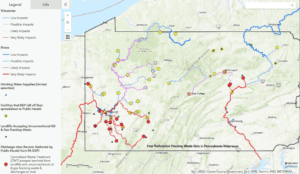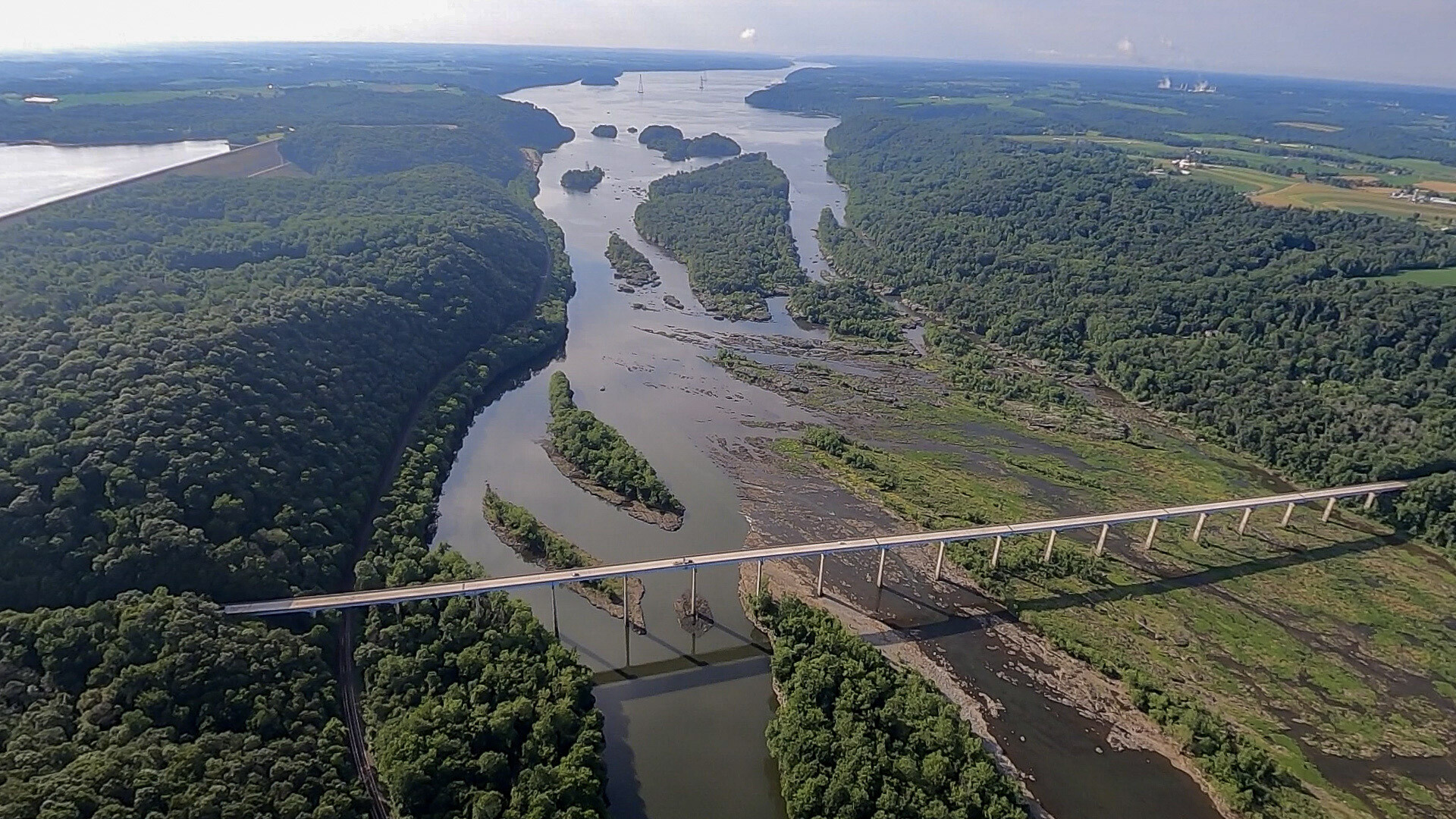
NORTHUMBERLAND COUNTY (April 18, 2024) – After years of community and legal advocacy, the residents of Northumberland County can breathe a clean sigh of relief.
Today, the Texas-based Encina corporation announced that it is withdrawing its plan to develop a toxic plastics chemical recycling plant along the banks of the Susquehanna River in Point Township, Northumberland County.
The now-dead plastic chemical recycling plant faced immediate community opposition when it was announced in 2022. The proposed facility—which would have been the largest of its kind in the United States—intended to use extreme heat and refining processes to convert plastic into toxic benzene, toluene, and xylene to be shipped by rail throughout the state, raising major air quality and safety concerns. The process would have used 2.9 million gallons of water a day from the Susquehanna River, threatening to pollute a vital source of drinking water with microplastics and PFAS.
“This is a huge win for the residents of Northumberland County, for the six million people who use the Susquehanna for drinking water, and for all Pennsylvanians who have a constitutional right to clean air,” said Alex Bomstein, Executive Director of Clean Air Council, which has been supporting residents and applying legal scrutiny on the project. “Chemical recycling is not a solution to the plastics crisis. Encina sold false promises to our state, and this must be a wake-up call to elected officials that toxic boondoggles like chemical recycling have no place in Pennsylvania.”
“This project threatened the region’s clean air and water and would have harmed our way of life in the area, especially for the people who live next to the proposed facility,” said Sandy Field, member of the local residents group Save Our Susquehanna. “Community members stood up and spoke out about these unacceptable risks, and Save our Susquehanna is thrilled that Encina will not be building their toxic chemical plant in our area. But we do not wish this plant on others, and we will continue to warn other communities about chemical recycling and the danger it poses to communities.”
“This community is safer without Encina’s proposed chemical recycling plant looming in the floodplains. Chemical recycling isn’t a solution to plastic waste, but rather a transformation of plastic waste like a bottle in the river, into toxic air, soil and water pollution for the community,” said Jess Conard, Appalachia Director at Beyond Plastics. “Encina’s departure is a welcomed relief for everyone, and it has been an honor to work alongside the Save Our Susquehanna team.”
The death of this project follows the closure of a similar chemical recycling facility in Oregon, and major issues at other facilities in Ohio, Indiana, and North Carolina. Despite the industry’s poor track and lack of technical and economic viability, more chemical recycling facilities are proposed and the industry has successfully lobbied state governments, including Pennsylvania, to avoid regulations intended to protect residents.
“The significance of this win cannot be overstated,” said Bomstein. “But the fight is not over. Toxic chemical recycling is a false solution to the plastics crisis. It doesn’t belong in Point Township. It doesn’t belong in Pennsylvania. And it doesn’t belong in any other community.”

PA, NJ, DE, NY – In a rarely taken step, today the U.S. Environmental Protection Agency (EPA) granted a legal petition filed by a coalition of leading environmental organizations regarding the health of the Delaware Estuary and its aquatic life. In a landmark determination, the EPA exercised its Clean Water Act Section 303(c)(4)(B) authority to begin the process of promulgating new water quality standards for the Delaware River estuary, superseding the authority of the regional Delaware River Basin Commission (DRBC), which has thus far failed to uphold its obligation to protect the health of the Delaware River Estuary and its robust aquatic ecosystem. This decision formally recognizes the need for greater oversight and protection of aquatic life in the Estuary, including the federally endangered and genetically unique Atlantic sturgeon population.
Originally filed in April of 2022 by Delaware Riverkeeper Network, Clean Air Council, Environment New Jersey, PennFuture, and PennEnvironment, the petition urged the federal government to promptly initiate rulemaking necessary to protect aquatic life in the Delaware Estuary. The petition claims that the DRBC and the four watershed states have failed to recognize that the Delaware Estuary, from Trenton to the top of the Delaware Bay, is being used for maintenance and propagation of resident fish and other aquatic life, as well as for spawning and nursery habitat for anadromous fish, including the federally endangered Delaware River Atlantic sturgeon. Similarly, the DRBC has failed to take action to institute water quality criteria essential for protecting existing uses by critical species such as the Atlantic sturgeon. The DRBC and the four watershed states have been repeatedly and formally urged to recognize these aquatic life uses and upgrade associated water quality protections, particularly dissolved oxygen standards. Until now, these requests have failed to spark the necessary protective actions required under the Clean Water Act to preserve the health of the Estuary.
In the determination released today, the EPA stated:
“EPA’s evaluation of available information . . . indicates that “propagation of fish” is attainable in the specified zones of the Delaware River Estuary. Additionally, the currently applicable dissolved oxygen criterion for these zones is not sufficient to protect propagation throughout the specified zones.
“Accordingly, EPA is determining, pursuant to [Clean Water Act (CWA)] Section 303(c)(4)(B) and 40 CFR 131.22(b), that: 1) revised aquatic life designated uses that provide for propagation of fish, consistent with CWA Section 101(a)(2) and 40 CFR 131.20(a); and 2) corresponding dissolved oxygen criteria that protect a propagation use, consistent with 40 CFR 131.11, are necessary for zone 3, zone 4, and the upper portion of zone 5 (in total, river miles 108.4 to 70.0) of the Delaware River Estuary, to meet the requirements of the CWA.”
This decision comes on the heels of a rally to save the River’s Atlantic Sturgeon at Philadelphia City Hall, hosted earlier this month by the Delaware Riverkeeper Network and partner organizations: Green Amendments For The Generations, Waterspirit, Saddlers Woods Conservation Association, Food & Water Watch, Clean Water Action, and Brandywine River Restoration Trust. The rally, which called upon the DRBC, EPA, U.S. Army Corps of Engineers, and the National Marine Fisheries Service (also known as NOAA Fisheries) to take accountability for their lack of sturgeon oversight and protection, featured a mock funeral procession, a coffin supported by pallbearers representing various regulatory agencies, and 180,000 paper sturgeon piled high into wheelbarrows, illustrating the massive loss of life from the River’s genetically unique population.
“EPA’s decision to grant our petition is powerful and important and may be a last best hope for saving the genetically unique Atlantic Sturgeon of the Delaware River from the lack of oxygen so severely compromising their continued existence,” noted Maya van Rossum, the Delaware Riverkeeper and Leader of the Delaware Riverkeeper Network. “We have been advocating for decades that our governmental agencies, including the DRBC, have failed to prioritize water quality and river protections essential to save our genetically unique population of Atlantic sturgeon. It is extremely rare that EPA grants a petition of this kind. EPA’s agreement that the DRBC has demonstrated an unwillingness to do the job necessary is both a powerful repudiation of the failed DRBC strategy and an acknowledgement of the perilous status of our Atlantic sturgeon. Many told our coalition not to bother petitioning the federal government, but the sturgeon need champions willing to pursue every path essential to protect them, as do our human communities who depend upon a healthy Delaware River. This victory is a vindication of the power of our dedication.”
“The ecosystem of the lower Delaware River has been living with standards that pre-date the Clean Water Act for more than 50 years. Endless studies have been committed to analyze and revise the dissolved oxygen standard for the Delaware – the ecological equivalent of the river’s pulse – to avoid death zones for the river’s most vulnerable species like the endangered Atlantic sturgeon. Today’s decision by EPA to grant our petition is an extraordinary step to recognize the lack of action by DRBC on this issue for decades – and to finally ensure the lower Delaware River can be a healthy, vibrant river,” said Doug O’Malley, Director of Environment New Jersey.
“EPA’s decision to protect the lower Delaware is a long-awaited victory for Philadelphians and neighboring communities. We look forward to cleaner, safer water for the many residents who enjoy this critical waterway and the wildlife the river supports,” added Joseph Otis Minott, Executive Director and Chief Counsel, Clean Air Council.
“The EPA made the right decision by recognizing that improvements to the lower Delaware River’s water quality supports all stages of aquatic life—not only for sensitive wildlife populations like the Atlantic Sturgeon, but also for our communities that enjoy the river,” stated Jessica O’Neill, Senior Attorney, PennFuture. “By granting our petition, EPA is following both the letter and the spirit of the Clean Water Act to protect and maintain our nation’s waters.”
“The Delaware River is undoubtedly one of the region’s greatest outdoor resources and natural places, and Delaware Valley residents from all walks of life want it protected and restored,” noted David Masur, Executive Director, PennEnvironment. “PennEnvironment applauds the EPA because our nation’s environmental cops are doing whatever it takes to protect this beloved waterway and the wildlife that make the Delaware River their home.”
To learn more about our ongoing efforts to protect the Atlantic Sturgeon, please visit: www.dinointhedelaware.org

Growing up in Southwestern Pennsylvania is a beautiful experience. The region’s rivers, mountains, and picturesque small towns and beautiful cities make this an ideal place to live and grow up in. People in the area goboating, water-skiing, and swimming in the summers andhiking, snowboarding, and skiing in the winters. Fall brings beautiful,world-renowned colors, while spring is a budding new world to explore. Could you imagine a better place to live and raise a family?
However, there’s a terrible secret that the fracking industry has tried to hide from families living in the region: there is radioactive material from fracking appearing in our waterways and drinking water.
The fracking industry has taken advantage of an outdated loophole in PA law that labels fracking waste as residual waste. This is known as the radioactive fracking waste loophole. This dangerous loophole permits industry to dump radioactive fracking waste in local municipal landfills, which then turns into a watery substance called leachate. While there has been in-depth reporting on the gas industry’s radioactive secret, including from reporter Justin Nobel from the Rolling stones, many Pennsylvania residents remain unaware.
One landfill in Westmoreland County is threatening the entire Monongahela River when it knowingly accepted radioactive waste. The leachate from the fracking waste in this landfill became radioactive, and was piped directly into the Monongahela River to the Belle Vernon sewage treatment plant.
Water treatment centers in the surrounding region were confused about why all of their beneficial bacteria were dying. The chemicals released by the radioactive leachate were killing everything good and bad. Despite the public health impacts from the radioactive leachate, the Pennsylvania Department of Environmental Protection lets operations continue at the landfill company with only a small fine.
No resident should be forced to deal with radioactive material in their drinking water. Shockingly, most Pennsylvanians that live in Southwestern Pennsylvania are being exposed to radiation.
The solution is simple. We must close the fracking waste loophole by labeling fracking waste as radioactive. This would prevent the oil and gas industry from being able to dump radioactive fracking waste in municipal landfills.
Clean Air Council is supporting legislation in the Pennsylvania House and Senate introduced by House Representative Sara Inamoratoe and Senator Katie Muth that would repeal the language under Title 58 that exempts the oil and gas industry from complying with the provisions of the Solid Waste Management Act and classify drilling waste as “hazardous waste” under the Solid Waste Management Act.
The Council is dedicated to ending this radioactive fracking waste loophole and protecting drinking water for the millions of people who depend on it in Southwestern Pennsylvania .
For more information about this issue, please contact Lois Bower-Bjornson, Outreach Coordinator, lbb@cleanair.org

